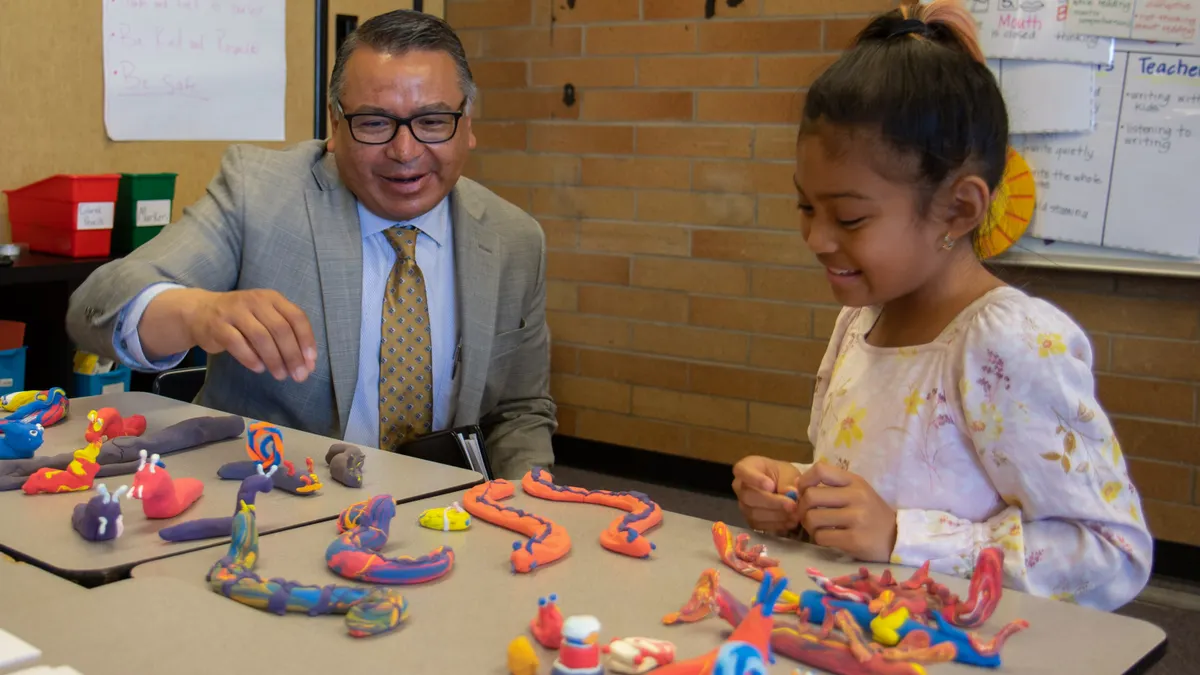If asked to name where one of the most innovative school districts in the U.S. is located, most people probably wouldn’t immediately respond with South Carolina. Yet the state, ranked No. 44 in the nation for education by U.S. News & World Report, is home to just that type of district in suburban Columbia’s Richland School District Two.
“I've mentioned to people before, sometimes South Carolina gets a national general bad rep for what people believe is the education system in the state,” Shambi Broome, a Richland Two parent originally from California, told K-12 Dive. “And I’ve always provided, ‘Well, that's never been our experience. I've always been impressed.’”
The nearly 28,000-student district has received recognition for rethinking grading policies with equity at the forefront, focusing on magnet programs for specialized education experiences, and offering innovative hands-on learning opportunities via the Richland Two Institute of Innovation (R2i2) incubator program.
Since stepping into the superintendency in 2017, Baron Davis, a homegrown educator, has prioritized the recruitment and retention of male teachers of color via his Premier 100 initiative. He has also engaged the community in passing bond referendums, including one for $468 million in 2018, to support school facilities improvements.
Of particular importance over the past 20 months, the district’s foresight on 1:1 device programs also placed it on relatively solid ground when learning had to pivot online in March 2020 due to the COVID-19 pandemic.
Not only was the district a step ahead in being able to deploy devices and hotspots to students while using state assistance to close some remaining gaps, but also on training educators and having network protection in place, said Nathan O'Neill, Richland Two innovation program designer.
Director of Instructional Technology Chuck Holland “has a couple of tech integration specialists at the whole district level, and their job is to coach district staff leadership,” said O’Neill. “And then also there's a person at every school called a TLC, which is a tech learning coach.”
Those coaches, he said, are focused on helping teachers make sure their lessons are in line with the SAMR model of substitution, augmentation, modification and redefinition to ensure education is really being transformed with the tech.
“We were in a much better spot maybe than other folks would have been, because we just had people who can be there to answer all those questions about how this device works or how this could be used in a [certain] way now that we're all virtual or hybrid or whatever,” said O’Neill.
Foresight and the power of communication
Prior to the pandemic, Richland Two built a lot of social capital within the community — thanks in part to engagement and transparency from Davis and his team.
“Whenever there is an issue of concern, we deal with it as a family. We talk about our successes. We talk about areas that only improve as a family,” said Jeff Temoney, principal at Spring Valley High School.
During the recent state of the district address, Temoney said, Davis talked about how far Richland Two has come, as well as the vision for the future and what still needs to be improved to make more opportunities for students, 56.2% of whom live in poverty.
“We shouldn't be the same — and we’re not — coming out of COVID, because this experience has taught us so much,” Temoney said. “But talking with us, he doesn't say ‘stakeholders’ anymore. That's a word we don't use as much. We say ‘partners.’ We're community partners.”
Attention to subtle details like that and a strong vision of what the school district of the future should look like have been essential to gaining buy-in and selling taxpayers on improvement efforts.
“At the last board meeting, there was discussion on rezoning, which is always a tough thing,” Temoney said. “But they had several sessions. They had surveys for parents, and they explained at the board meeting why they made the decision. Even if a parent doesn't agree, you see, ‘Wow, we have to move in this direction, because if we don't, it's going to be detrimental to kids in two years or three years. We put it out there. We're being as transparent as possible.”
In one of the clearest examples of the district’s forward thinking, the R2i2 program gives students an opportunity to engage in hands-on learning to solve local and global community problems, sometimes collaborating with peers in schools around the world, while strengthening skills in creative thought, leadership, collaboration and entrepreneurship.
The program has received funding from partners including the Samsung Solve for Tomorrow competition, South Carolina Department of Health and Environmental Control Champions of the Environment grant, Sparkleberry Fair Teacher Grant, U.S. Department of State Global Teacher Grant, and the Richland County Soil and Water Conservation District.
In recent projects, R2i2’s Next Energy engineering students have tackled climate justice, sustainable food and energy solutions, an inline flood advisory system and more.
“Having the diversity of thought and students coming from different perspectives, different experiences, really strengthens not just the prototypes and solutions they build, but their ability to work internationally with other schools and people,” said Kirstin Bullington, Next Energy engineering instructor at R2i2.
Expanding opportunities for male teachers of color
Perhaps Davis’ signature initiative in Richland Two, Premier 100 is the result of an examination of data on the impact men of color have in classrooms, “particularly African American men as relates to African American children and the impact it had on those students’ graduation rates and the students' perceptions of themselves,” Davis told K-12 Dive in June.
The district also wanted to make sure students were exposed to diverse learning experiences from teachers with a variety of backgrounds and perspectives. The district’s student population is 61% African American.
“The vast majority of your teachers in any given school district in this country are women,” said Davis. “We had a decent representation of Black women in our classrooms, but we wanted to put some emphasis on having Black males in our schools. The national average is about 2%.”
Through the program, the district has established structures for mentoring and networked with local historically Black colleges and universities for recruitment. It also collaborates with Clemson University’s Call Me MISTER program to bring prospective teachers to the district, give them an opportunity to see what being a teacher in Richland Two schools is like, and connect them with mentors who are men of color already in the district.
“If they're not given an opportunity to become these intellectual giants they're capable of being — people who shape and influence curriculum, people who are given certain leadership opportunities particularly if we’re talking about the focus on curriculum and instruction — they’re sometimes relegated to these roles of disciplinarians or being seen as ‘Black boy whisperers’ to deal with all the discipline problems that may occur within a school or the classroom,” said Davis.
"Recruitment and retention of men of color in our school district continues to move forward," said Davis. "We've done a great job of recruiting and retaining men of color in the classroom during a global pandemic. We haven't even been able to do it outside of the pandemic yet, and yet we're doing well."


















